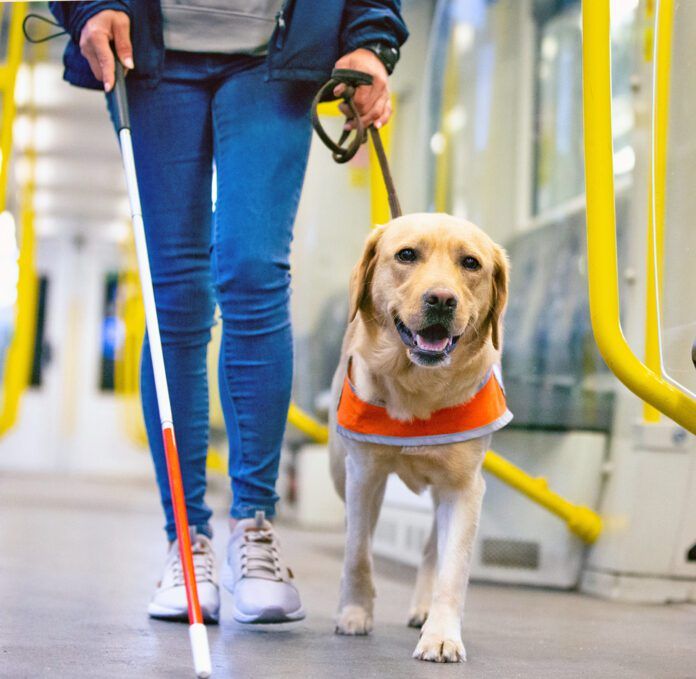While service dogs are loved as much as pets, these canines are not pets. They are working animals trained to do a job, and that training is specialized. The dogs are trained to do work or perform tasks for a person with a disability.
Common Service Dog Tasks
Service dogs fall into three categories, depending on their size, temperament, and training:
- Psychiatric service dogs
- Post-traumatic stress (PTSD) service dogs
- Mobility service dogs
The tasks within each category vary but are specific to the job the dog is trained to do.
Owning a service dog can greatly improve the lives of people with disabilities, according to research.
Psychiatric Service Dog Tasks
Psychiatric service dogs “help their owners cope with stressful situations, survive crises and panic attacks, and also become a physical mainstay if a person is dizzy or faint,” according to the Americans with Disabilities Act. These are not “emotional support dogs.”
Psychiatric Service Dogs are used as a connection to reality for people who suffer from paranoia, schizophrenia, or hallucinations. And their companionship can also be used as a therapy for antisocial or bipolar behavior.
PTSD Dog Tasks
PTSD dogs undergo specific training to recognize the symptoms of this condition, such as nightmares or seizures.
They’re trained in:
- Deep pressure therapy (DPT), which means lying on his owner to hold him down during a nightmare or flashback
- Interruption therapy, which means interfering with a potentially harmful behavior by licking or nuzzling or waking up their owner during a nightmare
- Movement tasks, which means circling their handler to prevent that person from moving into a dangerous situation or to control a dangerous situation
- Guide tasks, which means guiding their handler to a specific location or around objects
- Call tasks, which means pressing a specific button on a phone to call a person or 911 in an emergency.
Research shows these dogs do improve the lives of people battling PTSD.
Mobility Service Dogs
Mobility service dogs are trained to guide a blind or deaf person, pull a wheelchair using a special harness, or help a person move in a variety of other ways.
Therapy Dogs
Therapy dogs can help a person deal with a variety of other mental or physical challenges, but they are not considered a service dog because they do not perform an specific tasks for the person.
Certified Service Dogs
All government offices, businesses, and non-profit organizations must allow certified service dogs in public places, according to federal law. Hospitals are not required to allow – but may allow – service dogs to enter, except for operating rooms or burn units, where sterilized conditions are imperative.
Dogs whose only purpose is to provide comfort or emotional support are not service dogs, according to the ADA, because “providing emotional support or comfort is not a task related to a person’s disability.” But these dogs may fit under a wider definition of service dogs under the Fair Housing Act or Air Carrier Access Act.
The ADA requires service dogs “to be under control of the handler” at all times, so he “must be harnessed, leashed or tethered, unless the individuals’ disability prevents using these devices because they prevent the safe and effective performance of his tasks.” If that’s the case, he must be under control via voice or signals.
Many dogs are specifically raised to be service dogs, if you are looking for a dog. Do your research if you need one of these dogs and work with a professional trainer or organization for help training the dog. Be aware there are scams out there, which can only lead to heartache or worse.
Many people with disabilities think their dog can be a service dog just because they say it is. But that’s not correct.
A true service dog has had special training either by the handler or a professional trainer to provide his handler with a specific type of assistance, such as post-traumatic stress syndrome care or pulling a wheelchair. And the dog has been certified to do so by being registered under the Americans With Disabilities Act. Registration isn’t mandatory, but it can be helpful if you’re questioned about what your dog is trained to do for you.
Many dogs can be trained to provide other types of aid and not be certified. But they may not be allowed to enter certain public and non-public areas without certification or live in non-pet housing, often depending on local laws.
The U.S. Department of Justice has administered the Americans with Disabilities Act since it was enacted in 2011. It offers a registration program and identification. (IIt offers online registration and an ID card for $49 and just registration for $29).
Service dogs usually wear a harness or vest identifying them as such, but that is not necessarily enough to allow the dog access to all areas, and it is not required.






